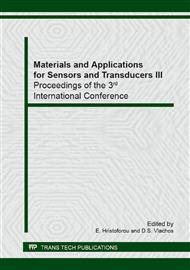p.306
p.310
p.314
p.318
p.322
p.326
p.331
p.335
p.340
The Multifunctional Composite on the Base of Carbon Nanotubes Network and its Use as a Passive Antenna and Gas Sensing Element
Abstract:
Carbon nanotubes in the form of entangled network can be used as a multifunctional composite material for a wide range of using. A new and perspective usage is a passive antenna and gas sensing element. The antenna works well at 1.284 GHz. The local reflection minimum is 11.48 dB. The reflection coefficient r=0.2667. The transmission power in this frequency is 93%. Multiwall carbon nanotubes (MWCNT) network Buckypaper was made by the vacuum filtration method of MWCNT aqueous suspension. The sensitivity of multi-wall carbon nanotube (MWCNT) networks of randomly entangled pure and HNO3 oxidized nanotubes to polar and nonpolar organic vapors (ethanol, heptane), has been investigated by resistance measurements. The results demonstrate that the network electrical resistance increases when exposed to organic solvent vapors, and a reversible reaction is observed when the sample is removed from the vapors. The investigated MWCNT networks could be potentially used as sensing elements for sensitive and selective organic vapor detection.
Info:
Periodical:
Pages:
322-325
Citation:
Online since:
April 2014
Authors:
Keywords:
Price:
Сopyright:
© 2014 Trans Tech Publications Ltd. All Rights Reserved
Share:
Citation:


